First drive: 2017 Porsche 911 1,000,000 and 911 classics in Scotland (’67 Targa, ’85 Clubsport, 964 Turbo & 996 GT3)

It’s not very often a car museum wheels its finest exhibits out the door, transports them to a destination with fantastic driving roads, throws you the keys and says: “Here you go. Have fun!” It’s not a common occurrence even for us weather-beaten career motoring hacks. However, the Porsche Museum handed a small selection of automotive hacks from around the globe (including this DriveArabia scribe) what amounted to an early Eid present, laying on an epic road trip through the Scottish Highlands in some of the finest ‘toys’ in its collection.
It wasn’t a random gesture though, as the event was conceived to celebrate the production of the one-millionth example of the German brand’s convention-defying 911 sportscar. The seven-digit vehicle -– an ‘Irish Green’ Carrera S –- is a special one-off that’s also bound for the Porsche Museum once it’s completed a brief world tour taking in a handful of countries.

We fortunate journos would be getting the rare honour of putting some real-world miles on not only the milestone car’s odometer, but also a selection of key 911 models through the ages, enabling us to create our own personalised time capsules of Zuffenhausen’s iconic rear-engined sportster.
Among the tantalising museum pieces available for us to steer across some of the most epic roads in Scotland are a 1967 911 Targa, a 1985 911 Carrera Clubsport G-series prototype (the only one in the world), a 1991 911-964 Turbo and a 2000 911-996 GT3. Each of these is a seminal car in its own right, so we would be getting our paws on bona-fide slices of history.
Without further ado, let’s cut to the chase with some seat-of-the-pants impressions of each of these classics.
1967 Porsche 911 Targa

The 911 Targa was conceived in the mid-sixties as a pre-emptive measure of sorts as, at the time, US safety regulators were threatening to outlaw open-topped cars due to their lack of rollover protection. The Targa (named after the storied Targa Florio road race in Sicily) addressed this by having a fixed stainless-steel roll bar and detachable roof panel – essentially making it the world’s first “safety convertible”.
On sale from January 1967, the first Targa had a plastic rear window (later replaced by a fixed glass screen) that could be unzipped and folded down.
Stuffed in the car’s rump was a 2.0-litre flat-six eking out 130 hp, which propelled the 1080 kg drop-top to 100 kph in 9.1 seconds and on to 210 kph if you kept the foot planted. Pretty good numbers for its day.
I’ve previously driven a selection of 1960s sportscars – among these are a couple of Jaguar E-Types and C1, C2 and C3 Corvettes – and the prevailing memory is of how simply awful they were to pedal. The best thing to do was to simply get out, stand back and admire their visual purity.
In this context, it comes as a surprise to find how tight and relatively easy to drive the Targa feels from behind the wheel. The 2.0-litre motor is decently punchy, and it’s also more tractable than one would have thought, given its small displacement. The four-speed manual it’s hooked up to is also reasonably slick, even though the wand-like gearstick that sprouts from the floor has to be moved a fair distance to swap cogs.

The interior is predominantly black, as was the Teutonic way, but there is some design flair in its large four-spoke steering wheel and the instrument cluster with its five dials sitting in an expansive row. The metal strip across the dash also helps break up the all-black monotony.
Curiously, the heater is activated by pulling up a bafflingly placed lever (with no labelling) next to the handbrake. It all adds to the quirky charm of the likeable Targa.
The Targa adopts some amusing lean angles as we hustle it across the twisty tarmac that takes us from Loch Lubnaig to Spean Bridge, but it manages to keep pace with the rest of the (much newer) 911 convoy, which proves an eye-opener for both me and my co-driver.
Most importantly, it comes across as an engaging driver’s car, with its variety of oil/petrol-infused aromas (synonymous with vehicles of its age) and the chuntering of the flat-six adding richness to the experience. It feels like a live organism in your hands – not remote and synthesised, like today’s cars.
1985 Porsche 911 Carrera Clubsport prototype

In 1985, Porsche built an experimental model designated “911 F 22, prototype sports package 2”, and this was to form the basis for the sought-after 911 Carrera Clubsport, of which just 340 units were built from 1987-89.
It was a minimalist car in the truest sense, foregoing air-con, electric windows, back seats, sound insulation material, central locking, and even the sun visor on the passenger side, enabling it to tip the scales at just 1160 kg (100 kilos lighter than the standard 911).
Although the Clubsport didn’t get a power hike, it scored lightweight intake valves and bespoke pistons and conrods, sharpening the 231 hp 3.2-litre motor’s response and enabling it to rev to 6,840 rpm – 320 revs above the standard engine. The engine tweaks were complemented by firmer, lower (by 30mm) suspension and a limited-slip differential.
Crucially, unlike today’s lightweight specials (which invariably command a price premium), the Clubsport costed about $2,000 less than its full-fat counterpart.
Visually, the Clubsport was distinguishable by its Fuchs wheels, Turbo-sourced whale-tail spoiler and ‘CS’ decals on the left-front and right-rear fenders. Personally, I think there’s a lot to like about the elegant simplicity of the Grand Prix White prototype with its matching white cookie-cutter wheels.

From behind the wheel, it initially feels unremarkable as it’s not blisteringly fast by today’s standards (0-100 kph in 6.1 seconds; 245 kph top speed), and nor does it seem exceptional in any other respect. It’s skittish across bumpy roads and there’s also loads of kickback through that four-spoke wheel with its rectangular hub.
But start putting some miles in the CS and it magically comes together as an overall entity. It literally seems to wrap itself around you and become an extension of your limbs. It’s so communicative and involving that you don’t need to be going like a bat out of hell to enjoy it. Even the ultra-spartan interior doesn’t detract from the experience.
The 3.2-litre motor has an intoxicating chatter, while the gearshift that seemed notchy at low speeds becomes slicker as you up the pace a bit. And the car’s apparent nervousness that’s initially disconcerting no longer becomes an issue as you become one with the Clubsport and learn to flow with it.
It’s a cliché, but this barebones stripper amounts to more than the sum of its parts. No surprise Clubsports now swap hands for princely sums, and that’s if you can find one for sale in the first place.
1991 Porsche 911-964 Turbo

In its era, this was one of the fastest road cars you could buy. With its 3.3-litre flat-six turbo pumping out 320 hp, the 1470 kg 911 (964) Turbo sprinted to 100 kph in 5.0 seconds and hit 270 kph flat out.
Although the basic recipe for this iteration of the Turbo was much the same as its predecessors, the 964 generation ushered in innovations such as airbags for the driver and front passenger, ABS and power steering. It also scored inner-vented, cross-drilled discs and four-piston callipers that could bring it to a standstill from 100 kph in just 2.8 seconds.
Unlike the Clubsport I’ve just stepped out of, this car has all the luxo mod-cons you could expect in its day – among these are a full leather interior, electrically adjustable seats, air conditioning, trip computer and a high-end Blaupunkt radio-cassette. Sliding into its all-grey cockpit, I settle into the sofa-like driver’s seat, which seems at odds with the lightweight velour-trimmed pew in the no-frills CS.

Early Turbos had a fearsome reputation for being tail-happy and difficult to drive, but the 964 is surprisingly soft, refined and easy to pedal. The 5-speed manual is also remarkably light and slick, and the clutch pedal isn’t overly heavy either, so there isn’t the need for Schwarzenegger-like forearms or quadriceps.
The 3.3-litre turbo motor serves up some lag at low to middling revs, but it’s not an on-off power delivery as acceleration comes in a smooth surge from about 3000 rpm onwards. Once you get sufficient revs on board, it’s as though a giant elastic band is flinging the car at the horizon.
The roads in the vicinity of Knockhill Racing Circuit are particularly lumpy, so the softly suspended Turbo is clearly made for this terrain, flowing across it all with no violent jarring transmitted through to the cabin (I later have a thrash across the same stretch in a 997 GT3 RS, and that nearly shakes my teeth fillings out).
For all intents and purposes, the 964 Turbo comes across as a remarkably docile car, yet it’s still able to set a brisk clip across the bumpy, twisty loop around Knockhill. The steering is decently feelsome and turn-in is crisper than the cushy suspension would have led one to believe.
All in all, a very useable and easy-to-live-with package (for its era), even though it delivers little of the addictive rawness and connectedness of the Clubsport. Not what I expected at all.
2000 Porsche 911 (996) GT3

It may look like a regular 911 wearing fancy-pants 10-spoke rims and an elaborate bi-plane rear spoiler, but the 996 GT3 was a proper hardcore, track-worthy offering when it was revealed in 1999 (it was also the first 911 to sport the ‘GT3’ suffix).
Its free-spinning 3.6-litre engine wasn’t a tweaked version of the standard car’s motor, but rather a derivative of the GT1 racer’s powerplant, with dry-sump lubrication and titanium conrods that enabled it to rev safely and smoothly to almost 8,000 rpm.
Other unique features included thin glass, along with several bespoke plastic and aluminium components. These, plus the turfing of all comfort features, kept its weight down to a lithe 1,350 kg. Factor in the uprated 360 hp engine, and the result was a car that sprinted from 0-100 kph in 4.8 seconds and hit a Ferrari/Lambo-humbling 305 kph.
The GT3 sat 30mm lower than its standard sibling, and the beefed-up suspension was adjustable for each racetrack. The braking system was also upgraded via 330mm discs, four-piston calipers and racing ABS. For those who wanted to take it further, there was a Club Sport package that included a roll cage, seats with fire-retardant upholstery, a six-point driver’s harness, fire extinguisher and battery main switch.

Despite its credentials, first impressions on getting behind the wheel are of how plain the sombre black interior is. Some cheap-looking plastic bits here and there also betray the cost-cutting Porsche carried out with the 996 generation. Fire it up though, and all this pales into insignificance.
The 996 was the first water-cooled 911, but in the case of the GT3 you can still feel the slightly lumpy beat of the flat-six, partly due to a lightened flywheel that sharpens throttle response. Once underway, the first kilometre or so is underwhelming, as the clutch pedal is heavy and the 6-speed manual is distinctly notchy and gritty.
The steering has a fair bit of play around centre, but there’s a highly textured feel (and kickback over lumpy surfaces) once you wind a bit of lock on.
On anything less than a perfect road surface, ride quality is bone-jarring – so much so that at times it seems there’s no suspension at all. The flip side is that the GT3 is exceptionally taut, grippy and precise as you begin to explore its capabilities. It’s a genuinely fast point-to-point car, even by today’s standards.
And that 3.6-litre motor is positively mighty. Throttle response is razor-sharp and it just begs to be wound out to 7,000-plus rpm. Do this and you hit high-triple-digit speeds with alarming rapidity.
It may be a bit one-dimensional – as it’s far from cossetting – but, as an unashamed trackday special, the 996 GT3 verges on sacred.
2017 Porsche 911 #1,000,000

You may have figured Porsche would build the one-millionth 911 as a hardcore GT3, Turbo S or ‘R’ variant, but the milestone car is in fact a Carrera S, as the company says this is the version most in line with the spirit of the 1963 original.
It’s not just any Carrera S though, as the car in question was fettled by Porsche Exclusive, and is resplendent in ‘Irish Green’, as this was company founder Ferry Porsche’s favourite hue (his first 911 was painted as such). This shade of green isn’t on Porsche’s regular palette, but it’s available to customers by special order.
There are other nods to the past, and among these are houndstooth cloth inserts in the black leather seats, a handmade mahogany steering wheel and matching wood trim (with a “911 Nr1,000,000” plaque) across the dash. The circular instruments (which also feature a “1,000,000 911” motif) have a silver surround, as per the original 911.
The crest on the bonnet is the same one that featured on the original 911, while the 20-inch Fuchs rims are inspired by the wheels worn by its ancestors, and the same goes for the gold badging on the rump and the ‘Galvano Silver’ wing mirror casings, door handles and air intake grille slats on the rear lid.
Mechanical tweaks are limited to a mildly uprated 450 hp motor – courtesy of larger turbos – plus the optional Sport Chrono package, a modified brake cooling system and bespoke sports exhaust system.
How does it drive? Pretty much the same as any current-model, 7-speed manual Carrera S, but the big takeaway is how much it contrasts with the yesteryear cars I’ve just stepped out of.
There’s no doubt it would be comfortably quicker around the Norsdschleife than any of the historic 911s I’ve just driven – and that includes the ultra-focused 996 GT3 -– yet the contemporary Carrera S feels comparatively Bentley-esque in terms of its refinement, premium cabin ambience and extensive array of mod-cons.
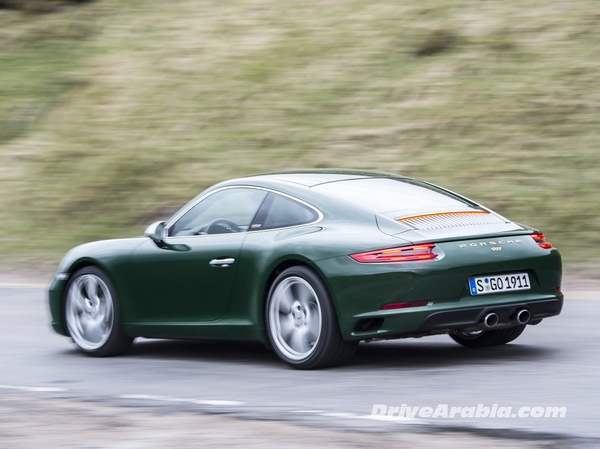
The 991.2 Carrera S is immensely easy to drive, whatever the conditions, and it isolates you far more from the action than its ancestors. Those analogue creatures all demand a degree of competence from the driver to bring out the best in them. In contrast, the newbie is a flattering car that pretty much anyone could step into and pedal relatively briskly.
Part of this evolution – which has chiselled out the original 911’s traditional (and charming) rough edges – is in line with changing customer demands, plus the fact that we spend far more time stuck in traffic and manacled by restrictive speed limits than was the case in the 1960s, ’70s and ’80s.
Consequently, the 911 has become an all-singing, all-dancing jack of all trades. It can hose off most upstarts around the ‘Ring, yet you can still comfortably pedal it all day, every day, even if the daily commute consists of nothing more than a stop-start schlep to work and back.
One has to admire the fact that Porsche’s engineers have found a way to so dramatically broaden the 911’s breadth of capabilities while still retaining a tangible link to the past. If it were my money, though, I’d quite happily opt instead for the slower and more demanding -– but also more character-infused -– 1985 Carrera Clubsport.
Photos by Max Mallen FRP/Porsche.
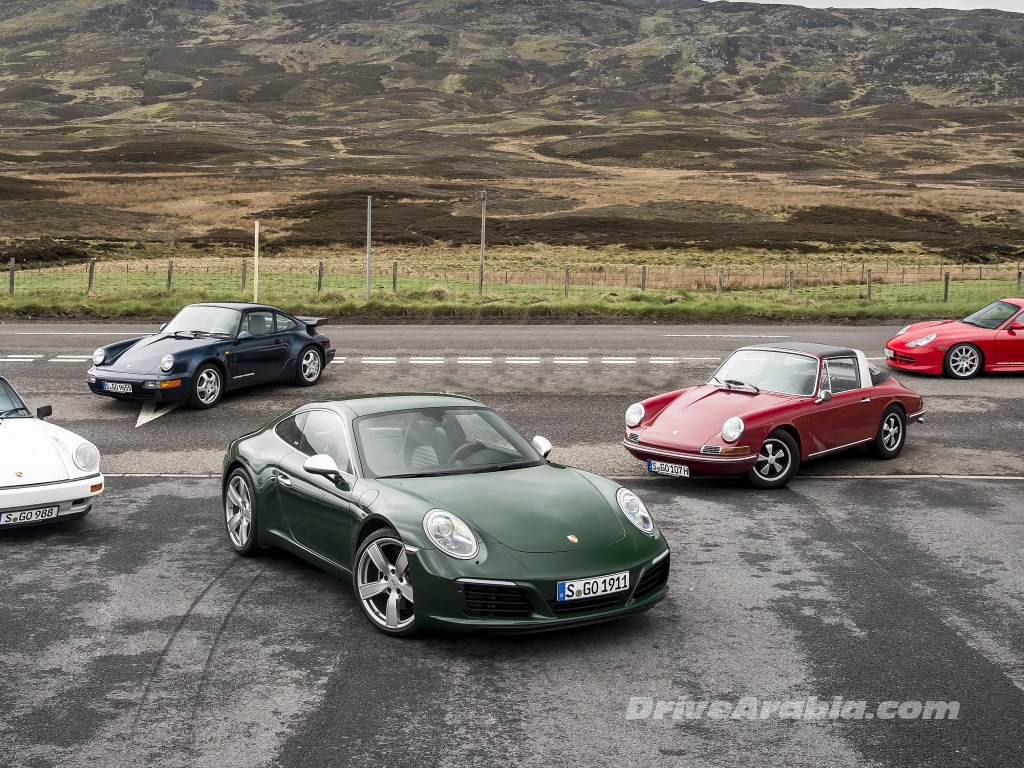



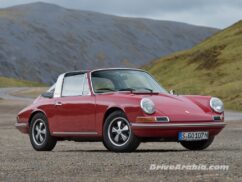
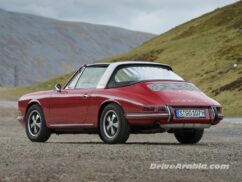
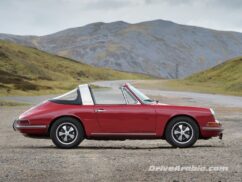


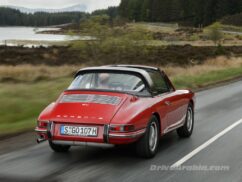

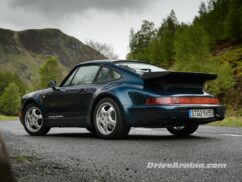

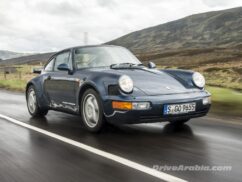
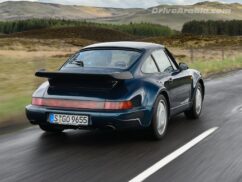




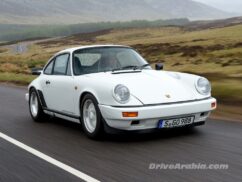






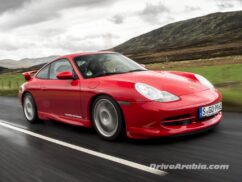
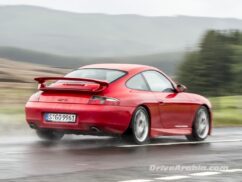
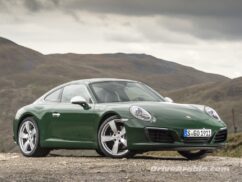

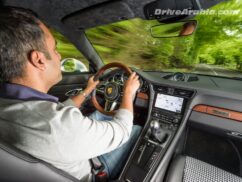

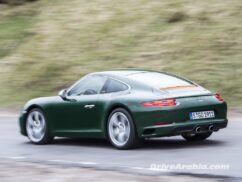
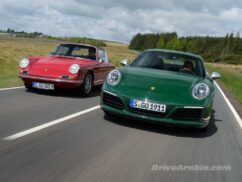
Comments
Asem
A true legend
marc
this, to me, guys, was the most thrilling/ best article ever on drivearabia. the 911 is a incarnation of sport cars and this was a nice snapshot of how the 911 evolved.